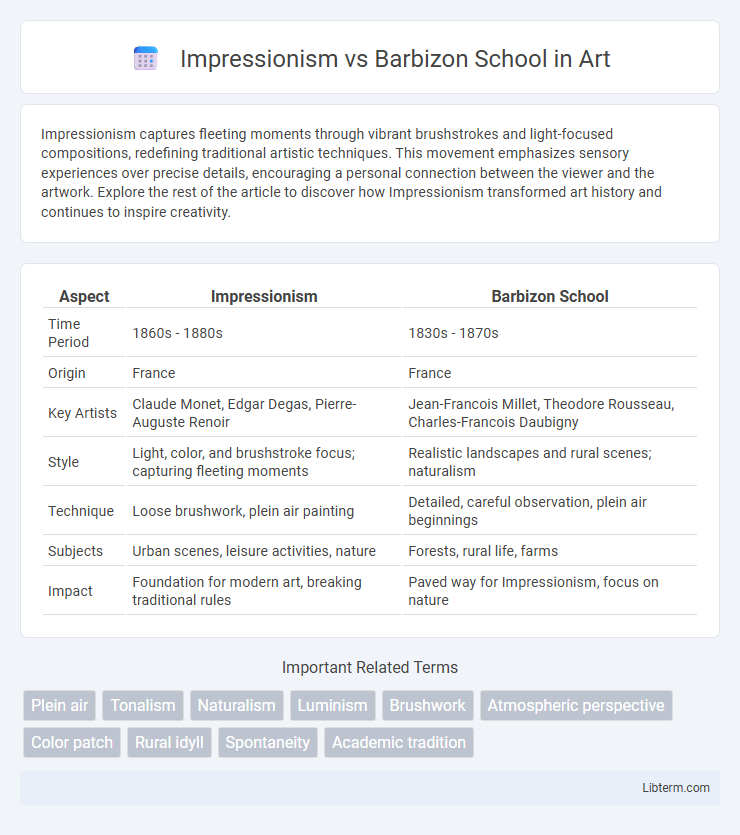Impressionism captures fleeting moments through vibrant brushstrokes and light-focused compositions, redefining traditional artistic techniques. This movement emphasizes sensory experiences over precise details, encouraging a personal connection between the viewer and the artwork. Explore the rest of the article to discover how Impressionism transformed art history and continues to inspire creativity.
Table of Comparison
| Aspect | Impressionism | Barbizon School |
|---|---|---|
| Time Period | 1860s - 1880s | 1830s - 1870s |
| Origin | France | France |
| Key Artists | Claude Monet, Edgar Degas, Pierre-Auguste Renoir | Jean-Francois Millet, Theodore Rousseau, Charles-Francois Daubigny |
| Style | Light, color, and brushstroke focus; capturing fleeting moments | Realistic landscapes and rural scenes; naturalism |
| Technique | Loose brushwork, plein air painting | Detailed, careful observation, plein air beginnings |
| Subjects | Urban scenes, leisure activities, nature | Forests, rural life, farms |
| Impact | Foundation for modern art, breaking traditional rules | Paved way for Impressionism, focus on nature |
Origins of Impressionism and the Barbizon School
The Barbizon School emerged in the early 19th century near the village of Barbizon, France, emphasizing realistic depictions of rural landscapes and natural settings, often painted en plein air. Impressionism originated in the 1860s as a reaction to both traditional academic art and the Barbizon approach, focusing on capturing fleeting light effects and atmospheric conditions with loose brushwork and vibrant color. Key figures in Impressionism like Claude Monet and Pierre-Auguste Renoir built upon the Barbizon School's commitment to outdoor painting but pushed towards spontaneity and sensory impression rather than detailed realism.
Key Philosophies and Artistic Goals
Impressionism emphasized capturing fleeting moments and the effects of light through loose brushwork and vibrant color palettes, prioritizing sensory experience over detailed realism. The Barbizon School focused on naturalism and the truthful depiction of rural landscapes, aiming to represent nature with emotional depth and a subdued, earthy color scheme. Both movements sought to break from academic conventions, with Impressionists pushing toward modernity and spontaneity, while the Barbizon artists championed a return to nature and the pastoral tradition.
Influential Artists in Each Movement
Impressionism, characterized by artists like Claude Monet, Edgar Degas, and Pierre-Auguste Renoir, emphasized light, color, and fleeting moments with loose brushwork and outdoor scenes. The Barbizon School, led by painters such as Jean-Francois Millet, Theodore Rousseau, and Camille Corot, focused on realistic rural landscapes and nature with detailed, atmospheric depictions rooted in the French countryside. Both movements significantly influenced modern art, with Impressionism pioneering contemporary visual perception and the Barbizon School advancing naturalistic landscape painting.
Differences in Subject Matter
Impressionism primarily captures fleeting moments of light and color in everyday urban and natural scenes, emphasizing atmospheric effects and spontaneity. The Barbizon School focuses on realistic, detailed portrayals of rural landscapes and peasant life, often highlighting the somber and tranquil qualities of nature. While Impressionists experiment with vibrant palettes and rapid brushstrokes, Barbizon artists favor earthy tones and meticulous techniques to represent the natural world.
Approaches to Light and Color
Impressionism emphasizes capturing transient effects of natural light through loose brushwork and vibrant, unmixed colors applied directly on the canvas, creating a luminous and dynamic atmosphere. The Barbizon School employs a more restrained palette and detailed rendering, focusing on naturalistic light and earthy tones to depict the serene, often muted ambiance of rural landscapes. While Impressionists explore the fluctuating intensity and color of light throughout the day, Barbizon artists prioritize a stable, realistic representation of light to enhance the mood and solidity of their scenes.
Techniques and Brushwork
Impressionism is characterized by loose, quick brushstrokes that capture light and movement, often using broken color and visible, vibrant brushwork to convey atmosphere and fleeting moments. In contrast, the Barbizon School emphasizes detailed, smooth brushwork with a focus on realistic landscapes and naturalistic light effects, using more controlled techniques to depict nature accurately. While Impressionists prioritize spontaneity and perception, Barbizon artists strive for careful observation and tonal harmony in their compositions.
Landscape Painting: Contrasts and Comparisons
Impressionism revolutionized landscape painting with its emphasis on capturing fleeting light and atmosphere using loose brushstrokes and vibrant colors, as seen in works by Monet and Renoir. The Barbizon School, predating Impressionism, focused on realistic, detailed depictions of rural landscapes and nature, emphasizing mood and naturalism through artists like Theodore Rousseau and Jean-Francois Millet. While both movements celebrated nature, Impressionism embraced spontaneity and optical effects, contrasting with the Barbizon School's grounded, earthy tones and meticulous observation.
Impact on Modern Art Movements
Impressionism revolutionized modern art with its emphasis on light, color, and spontaneous brushwork, directly influencing movements like Expressionism and Abstract Impressionism. The Barbizon School, known for its realistic landscapes and naturalistic detail, laid the groundwork for plein air painting and inspired later naturalist and realism trends. Both movements collectively shifted artistic focus from classical subjects to personal experience and nature, shaping the trajectory of 20th-century art.
Notable Masterpieces: Impressionism vs Barbizon
Impressionism's notable masterpieces include Claude Monet's "Impression, Sunrise" and Pierre-Auguste Renoir's "Dance at Le Moulin de la Galette," showcasing vibrant brushstrokes and light effects. The Barbizon School is renowned for works like Jean-Francois Millet's "The Gleaners" and Theodore Rousseau's "The Forest of Fontainebleau," emphasizing realistic landscapes and rural scenes. Both movements significantly influenced 19th-century art, with Impressionism focusing on light and momentary impressions, while Barbizon highlighted naturalism and mood.
Lasting Legacies and Influence on Contemporary Art
The Impressionism movement revolutionized contemporary art with its emphasis on light, color, and capturing fleeting moments, profoundly influencing modern visual techniques and plein-air painting. The Barbizon School's commitment to naturalistic landscapes and realistic depictions of rural life laid foundational principles for environmental awareness and authenticity in art. Both movements continue to inspire contemporary artists by blending emotional expression with detailed observation, shaping the trajectory of modern landscape and representational art.
Impressionism Infographic

 libterm.com
libterm.com